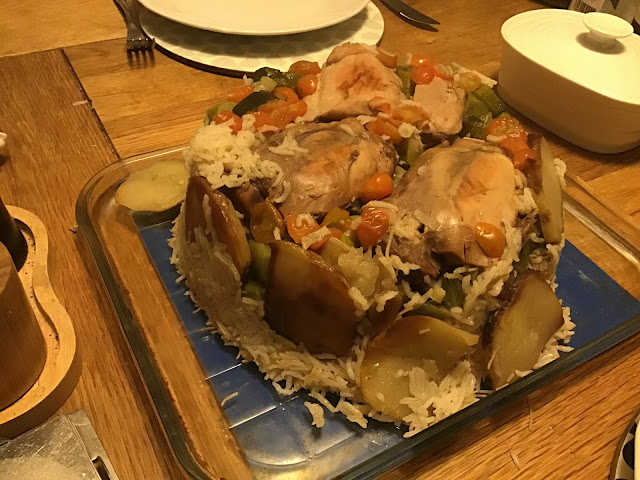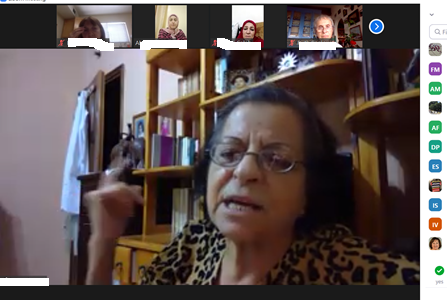Virtual trip to Bethlehem, Aida Camp and Al Walajah
Our second day on the virtual trip to Palestine was to Bethlehem – a town well known and with places that are Holy to Muslims, Christians and Jews.
I am grateful to have been shown around by local people and
to see the different approaches to help the local children manages their
situation. With Dr Abedfettah, the Director of Aruwad, the Cultural and arts
society in Aida refugee camp we visited the large refugee camp of Aida, where
many, many thousands of people are squeezed on to land of 0.007 square km. The
original wooden structures from people escaping the 1948 Nakba were replaced
with brick structures and due to the lack of land families would build upwards.
With a very young population, 45% being under 18, and very restricted space
with land given for recreation commandeered and walled off by the Israelis, the
Aruwad arts centre has become key to providing as wide a range of activities as
possible to not only keep the youth busy, but try to give them an important
sense of self and their potential. The projects looked wonderful, often with visiting
groups working in partnership to support the young people in arts, drama, music,
film, sports, and many other areas. It was inspiring to see such a positive
determination in such a difficult circumstance.
Our next guide was a spokeswoman from the Bethlehem
Municipality, who talked of her own experiences as well as giving a very
informative talk on the issues that Bethlehem faces with water, security, land
issues and, of course, the Wall.
The most memorable phrase was “When abnormal living is
considered normal” and I think this is the most significant issue across
Palestine. This is the lifestyle that the world does not see but needs to be
woken up to realise the total injustice of anyone having to live in this way.
It is so difficult to imagine all the complexities in living this way that
without the photographic evidence, people can easily believe this cannot be
true. When you see and understand the truth, the injustice hits you like a
bullet. Very movingly, our tour guide Nariman brushed quickly over her
personal experience as a child where a soldier tried to kill her, which left
her traumatised. She said this matter of factly, knowing that her story was
echoed by so many others who see this “abnormal living” as normalised, in order
to explain how she was introduced to the Aruwad Arts centre in Aida camp.
In this world-famous Holy town, visitors from across the
world want to come, as they do to every famous place in every country.
Worshippers want to come and spend time and money here to buy souvenirs of
their pilgrimage, and to pray and medicate in the place of Christ’s birth. The
tomb of Rachel is here and this is holy to all three Abrahamic religions; and
yet we are told that tourists must stay in Jerusalem, this boosting that economy,
and can only stay the night in Bethlehem if Jerusalem is full. Tourists are
rushed off without having any time to browse the local handcrafts; thus, critical
tourist economy is lost to the Bethlehem craft people and syphoned off to
Jerusalem for the mostly Israeli economy.
Our last guide was from a small village called Al Walajah,
which was so walled off that there is only one small entrance, and as Abed
recounted its hard not to accidently go to the Israeli settlement as the
village road is very close but not so obvious – but if any visitor did take the
wrong path they would likely be killed.
It is so moving hearing from the people wo live there; and despite still sadly being n the UK instead of actually being out there, talking directly with people living right now in Palestine is very moving. We were given important insights into history and especially the British part in the current situation which was very instrumental from the Victorian era until well past the 1948 war when we left munitions to help the Israelis against the Palestinians – something I hadn’t realised until I went there
My personal thoughts are these: Bethlehem seems to represent
in one microcosm, all the difficulties, importance, systematic abuse and
treachery of the way the occupiers treat the Palestinians. Land that was deemed
Palestinian, even after miles had already been carved away by the 1948 war, the
1967 war and many more incursions, was then carved even further by the
monstrous illegal wall. One picture shows a man with a prize olive tree,
centuries old on his land, had the tree demolished without a glance, and the
wall erected so close to his home slicing his land away from him, and leaving
his driveway hanging on the edge of a precipice cut away by the Israelis. The
pure destructiveness of this and of so much done by the Israelis in expanding
their own settlements is purely vindictive – directly against the human rights
and actually coming under the official definition of genocide: Genocide is not
only when people are killed in large numbers; but the definition includes when
a land is made uninhabitable in order to try and force people to leave. The
water situation is one of these – where not only can the people of Bethlehem
not get water easily, and when they have to buy it, it costs four times as much
as Israeli’s, the sewerage and waste water from Israel is pumped on to
Palestinian lands which then makes the and useless as pasture. Another example
of the impossibility to get any planning permission for any new build; and then
after warnings the Israelis can bulldoze the buildings saying that they don’t
have planning permission. More shocking is that the army can enter anyone’s
house and forcibly remove people – stories I heard before when I visited
Hebron. The world stays silent while the Palestinians are moved on to smaller
and smaller pieces of their own land. Now only 13% of the Bethlehem land can be
used by Palestinians.
All in all, a packed and informative trip – well put
together and emotional as well as interesting. Thank you all for your sharing
of time and experiences, and I wish you all peace and safety in what seems a
worsening situation.
Linda Rose



Comments
Post a Comment